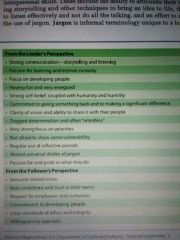![]()
![]()
![]()
Use LEFT and RIGHT arrow keys to navigate between flashcards;
Use UP and DOWN arrow keys to flip the card;
H to show hint;
A reads text to speech;
27 Cards in this Set
- Front
- Back
|
Management |
The process of leading and working with people to accomplish organizational goals and objectives using available resources efficiently and effectively. |
|
|
Work ethic |
The willingness and ability to get things done effectively and efficiently. |
|
|
Horizontal specialization |
The various divisions of labor across an organization. |
|
|
Leading |
Inspiring and motivating others to achieve organizational goals. |
|
|
Synergy |
The increase effectiveness that results from combined action or cooperation. |
|
|
Supervisor |
An individual who typically has the authority to hire, direct, promote, discharge, assign, reward, or discipline other employee. |
|
|
Controller |
A person who measures quality and performance. |
|
|
Transformational change |
Change that affects an entire organization. |
|
|
Characteristics of inspiring leaders |

|
|
|
Path goal theory |
A model that suggests leaders motivate their followers by providing clear goals and meaningful incentives for reaching them. |
|
|
Transformational leadership |
Leadership that inspires followers to share a vision, motivates and empowers them to achieve the vision, and provides coaching and support to develop their potential. |
|
|
Team |
A small group of people with complementary skills committed to a common purpose and specific performance goals. |
|
|
Trust |
A belief in the integrity, character, or ability of others. |
|
|
Empowerment |
The process of making employees full partners in decisiom making and giving them the necessary tools and rewards. |
|
|
Steakholder |
Anyone who has a vested interest in the success of an organization. |
|
|
Mission |
A formal statement of the core purpose of an organization that defines its objectives and focus |
|
|
Values |
The core beliefs of an organization and the principles that guide behavior. |
|
|
Job analysis |
The process of identifying the task and skill requirements for a specific job, determined by studying superior performers in related jobs |
|
|
Job description |
A document that outlines expectations, tasks, responsibilities, education, and skill requirements for a specific job. |
|
|
Job specification |
A written summary of the qualifications needed to successfully perform a particular job. |
|
|
Orientation |
An opportunity to introduce and welcome a new hire and begin the transition from new employee to contributing team member. |
|
|
Corporate culture |
The shared values, beliefs, traditions, philosophy, and character or personality of the organization. |
|
|
Performance appraisal |
The process of evaluating individual job performance as a basis for making objective personnel decisions. |
|
|
Six steps to training plan |
1. Conduct a needs assessment. 2. Developed an individual or a group training plan. 3. Select the methods and trainers. 4. Prepare employees to learn. 5. Conduct the training. 6. Follow up and evaluate effectiveness. |
|
|
Critical incident |
An appraisal technique in which specific instances of inferior and superior performances are documented when they occur. |
|
|
Quantitative measures |
Measures focusing on productivity or results that can be counted or measured. |
|
|
Qualitative measures |
Measures focusing on the level of excellence of a product or service. |

